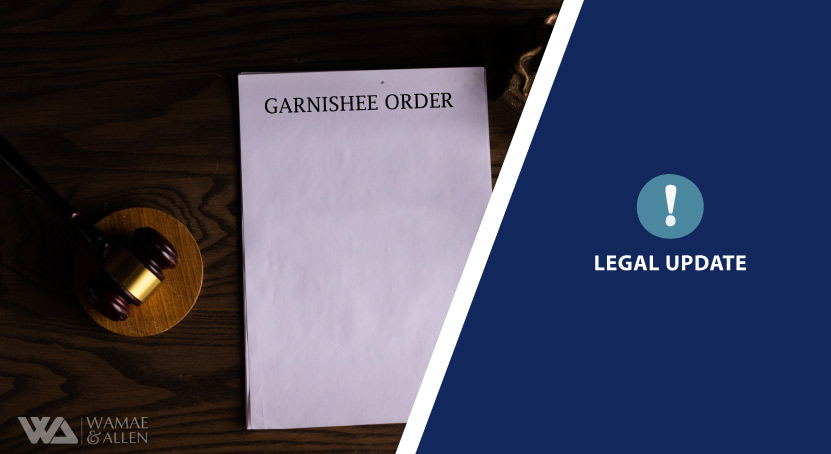A Garnishee is defined as a party who is in possession of money or property of a debtor and has been notified by a court or other legal body that that money or property must be made available to satisfy a monetary judgment to the party owed by the debtor. https://www.yourdictionary.com/garnishee. It is important to note from the outset that the garnishee is not the Judgment Debtor and does not assume the liability of the Judgment Debtor.
The common problem facing the banking industry is when garnishee orders are issued but mysteriously mutate to warrants of attachment of the bank’s property instead of an order attaching the monies in the judgment debtor’s account.
Countless banks have fallen victim to this mutation that defies legal comprehension as how the mutation occurred from an order of garnishee to an order of attachment.
The Problem and origin of unlawful attachments
Order 23 Rule 4 of the Civil Procedure Rules systematically sets out the execution procedure against a garnishee as follows:
Forms 17 and 18 of Appendix A also require that the costs of the garnishee must be set out and deducted before the sum of money duly attached is paid out. Of importance is that the forms:
- Are addressed to the Judgment Debtor
- Command the Garnishee to pay out the amounts in the bank account less the garnishees costs arising from the garnishee proceedings.
- Identify the amounts the Garnishee is indebted to the Judgment Debtor.
In many instances, the courts, instead of strictly complying with issuance of orders in conformity with Forms 17 and 18 of Appendix A, issue unlawful garnishee orders that do not comply with the strict requirements of the law. Warrants of attachment entitled “Warrant of attachment of moveable property in execution of decree for money” are issued to Auctioneers, name the bank as a Garnishee but direct the Auctioneer to attach the property of the Judgment Debtor.
The second illegality that now takes place is at the hands of the Auctioneer who:
- Deliberately fails, as an officer of the court, to scrutinize the warrants and take note that the bank is named as a garnishee and not the judgment debtor.
- Proceeds to proclaim all the banks tools of trade-computers, safes, filing cabinets, furniture etc.
- Imposes unlawful auctioneer’s fees to be paid by the bank personally
From the foregoing, the original sin lies with the court in issuing unlawful orders and warrants in the first place and compounded by an auctioneer who fails in his duties as an officer of the court to verify that the warrants are directed at a judgment debtor’s property and not that of the bank.
The law
A garnishee order is directed at the monies in the judgment debtors’ account and not at the garnishee’s property. The Court of Appeal in the case of Barclays Bank of Kenya Limited vs. Kepha Nyabera & 191 Others & Another (2013) eKLR observed saliently that a Garnishee’s property cannot be subject to adverse action in realization of a debt due to a judgment-debtor.
The court in Maurice M. Munya & 148 others v CFC Stanbic Bank Limited (formerly Stanbic Bank of Kenya Limited) (2019) eKLR held the garnishee was not a Judgement Debtor. The decree was not issued against it hence there was no lawful basis for attachment of the garnishee’s personal property. If there was delay or refusal to obey the order of the court by the garnishee, the proper procedure to pursue would have been contempt proceeding and not attachment.”
Even the Court of Appeal in England misapprehended the essence of a garnishee order leading to a successful appeal to the House of Lords in the case of Société Eram Shipping Co Ltd and others v Compagnie Internationale de Navigation [2003] 3 All ER 465. The House of Lords held, inter alia, that:
Attachment of Garnishee’s Property is Trespass
Further, the wrongful attachment of the garnishee’s property amounts to actionable trespass. A claim for damages can be successfully brought against the Auctioneer who in turn my seek indemnity from the advocate who applied for the warrants of attachment instead of the correct garnishee order absolute.
The auctioneer can also be subjected to disciplinary proceedings before the Auctioneers Licensing Board.
The Remedy-Request for Issuance of Practice Directions
Cognizant of the foregoing, the firm has petitioned the Chief Justice, pursuant to Section 16(1)(e) of the High Court (Organization and Administration) Act, to issue practice directions regarding issuance of warrants to Auctioneers pursuant to garnishee orders absolute. The directions should guide all courts as follows:
- Execution of garnishee orders absolute must comply with Forms 17 and 18 of Appendix A of the Civil Procedure Rules and the garnishee’s costs must be quantified and set out in the order. The costs are easily ascertained at the garnishee order nisi stage if the garnishee appears.
- Advocates should be directed to strictly apply for garnishee orders pursuant to Forms 17 and 18 of Appendix A of the Civil Procedure Rules and not apply for ordinary warrants of attachment.
- No warrants should be issued to auctioneers to attach a garnishee’s property pursuant to a garnishee order absolute and any such warrants should be set aside by the court suo motto.
This is one area of law that has been abused for decades and yet ignorance of the law is no excuse.
This article is provided free of charge for information purposes only; it does not constitute legal advice and should not be relied on as such. No responsibility for the accuracy and/or correctness of the information and commentary as set out in the article should be held without seeking specific legal advice on the subject matter. If you have any query regarding the same, please do not hesitate to contact Allen Waiyaki Gichuhi or Caxstone Phelix Kigata vide allen@wamaeallen.com or caxstone@wamaeallen.com.












